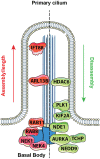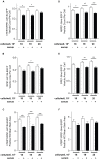Microscopy-Based Automated Live Cell Screening for Small Molecules That Affect Ciliation
- PMID: 30809247
- PMCID: PMC6379280
- DOI: 10.3389/fgene.2019.00075
Microscopy-Based Automated Live Cell Screening for Small Molecules That Affect Ciliation
Abstract
The primary monocilium, or cilium, is a single antenna-like organelle that protrudes from the surface of most mammalian cell types, and serves as a signaling hub. Mutations of cilia-associated genes result in severe genetic disorders termed ciliopathies. Among these, the most common is autosomal dominant polycystic kidney disease (ADPKD); less common genetic diseases include Bardet-Biedl syndrome, Joubert syndrome, nephronophthisis, and others. Important signaling cascades with receptor systems localized exclusively or in part at cilia include Sonic Hedgehog (SHH), platelet derived growth factor alpha (PDGFRα), WNTs, polycystins, and others. Changes in ciliation during development or in pathological conditions such as cancer impacts signaling by these proteins. Notably, ciliation status of cells is coupled closely to the cell cycle, with cilia protruding in quiescent (G0) or early G1 cells, declining in S/G2, and absent in M phase, and has been proposed to contribute to cell cycle regulation. Because of this complex biology, the elaborate machinery regulating ciliary assembly and disassembly receives input from many cellular proteins relevant to cell cycle control, development, and oncogenic transformation, making study of genetic factors and drugs influencing ciliation of high interest. One of the most effective tools to investigate the dynamics of the cilia under different conditions is the imaging of live cells. However, developing assays to observe the primary cilium in real time can be challenging, and requires a consideration of multiple details related to the cilia biology. With the dual goals of identifying small molecules that may have beneficial activity through action on human diseases, and of identifying ciliary activities of existing agents that are in common use or development, we here describe creation and evaluation of three autofluorescent cell lines derived from the immortalized retinal pigmented epithelium parental cell line hTERT-RPE1. These cell lines stably express the ciliary-targeted fluorescent proteins L13-Arl13bGFP, pEGFP-mSmo, and tdTomato-MCHR1-N-10. We then describe methods for use of these cell lines in high throughput screening of libraries of small molecule compounds to identify positive and negative regulators of ciliary disassembly.
Keywords: ADPKD; aurora kinase A; ciliary disassembly; drugs; heat shock protein 90; high content imaging; screening; targeted therapy.
Figures







Similar articles
-
Patterns of Ciliation and Ciliary Signaling in Cancer.Rev Physiol Biochem Pharmacol. 2023;185:87-105. doi: 10.1007/112_2020_36. Rev Physiol Biochem Pharmacol. 2023. PMID: 32761455 Free PMC article. Review.
-
Unexpected Activities in Regulating Ciliation Contribute to Off-target Effects of Targeted Drugs.Clin Cancer Res. 2019 Jul 1;25(13):4179-4193. doi: 10.1158/1078-0432.CCR-18-3535. Epub 2019 Mar 13. Clin Cancer Res. 2019. PMID: 30867219 Free PMC article.
-
Insights into the Regulation of Ciliary Disassembly.Cells. 2021 Nov 1;10(11):2977. doi: 10.3390/cells10112977. Cells. 2021. PMID: 34831200 Free PMC article. Review.
-
Ganetespib limits ciliation and cystogenesis in autosomal-dominant polycystic kidney disease (ADPKD).FASEB J. 2018 May;32(5):2735-2746. doi: 10.1096/fj.201700909R. Epub 2018 Jan 10. FASEB J. 2018. PMID: 29401581 Free PMC article.
-
INPP5E mutations cause primary cilium signaling defects, ciliary instability and ciliopathies in human and mouse.Nat Genet. 2009 Sep;41(9):1027-31. doi: 10.1038/ng.427. Epub 2009 Aug 9. Nat Genet. 2009. PMID: 19668215
Cited by
-
Renal Ciliopathies: Sorting Out Therapeutic Approaches for Nephronophthisis.Front Cell Dev Biol. 2021 May 13;9:653138. doi: 10.3389/fcell.2021.653138. eCollection 2021. Front Cell Dev Biol. 2021. PMID: 34055783 Free PMC article. Review.
-
Impaired Ciliary Beat Frequency and Ciliogenesis Alteration during Airway Epithelial Cell Differentiation in COPD.Diagnostics (Basel). 2021 Aug 31;11(9):1579. doi: 10.3390/diagnostics11091579. Diagnostics (Basel). 2021. PMID: 34573921 Free PMC article.
-
Live-cell fluorescence imaging of ciliary dynamics.Biophys Rep. 2021 Apr 30;7(2):101-110. doi: 10.52601/bpr.2021.210005. Biophys Rep. 2021. PMID: 37288144 Free PMC article.
-
Patterns of Ciliation and Ciliary Signaling in Cancer.Rev Physiol Biochem Pharmacol. 2023;185:87-105. doi: 10.1007/112_2020_36. Rev Physiol Biochem Pharmacol. 2023. PMID: 32761455 Free PMC article. Review.
-
Multi-color live-cell fluorescence imaging of primary ciliary membrane assembly and dynamics.Methods Cell Biol. 2023;176:235-250. doi: 10.1016/bs.mcb.2023.02.001. Epub 2023 Mar 27. Methods Cell Biol. 2023. PMID: 37164540 Free PMC article.
References
-
- Buchser W., Collins M., Garyantes T., Guha R., Haney S., Lemmon V., et al. (2012). “Assay development guidelines for image-based high content screening, high content analysis and high content imaging,” in Assay Guidance Manual, eds Sittampalam G. S., Coussens N. P., Brimacombe K., Grossman A., Arkin M., Auld D., et al. (Rockville, MD: Bethesda; ).
Grants and funding
LinkOut - more resources
Full Text Sources
Research Materials

